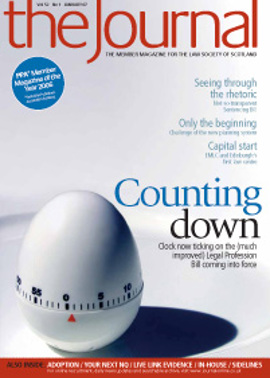Book reviews

Scottish Administrative Law
Jean McFadden and Dale McFadzean
PUBLISHER: Dundee University Press
ISBN: 1 84586 013 6
PRICE: £15
This book appears as part of the Law Essentials Series published by Dundee University Press. As such, it is one of a growing number of texts of much shorter length than the average student textbook which are intended as introductory texts or exam revision aids. Accordingly, it is appropriate to evaluate the book in the light of those purposes, rather than against the criteria appropriate to a traditional textbook or a practitioner manual.
The authors have done well to cover the full range of topics normally embraced by the term “administrative law” so briefly: the book extends to only 114 pages in a small format (including titles and index). In general, the exposition both of doctrine and institutions is both accurate, and up to date, and reasonably clear. However, I do have some quibbles, and suggestions for improvement for future editions.
Chapter 2 is devoted to doctrines of the constitution. This is clearly a topic that has to be covered but, given that space is at a premium in such volumes, too much material is included that does not really contribute to an understanding of the following chapters, or, at any rate, its relevance to administrative law is not made clear. An example is the discussion of separation of powers at pages 5-9.
Also, I would suggest that the treatment of judicial review is a little too “traditional”. Recent relevant constitutional reforms such as devolution and the Human Rights Act are certainly discussed, but in my view their significance is underplayed. This is particularly true of the Human Rights Act: its effect on judicial review is discussed solely in terms of proportionality, and the full implications of s 6 are not explored.
On a more specific point, and this may be consequence of the pressure on space in such texts, the treatment of the well-known presumptions of interpretation (against taxation, retrospective effect, denial of access to the courts, sub-delegation) might give the unwary student the impression that these are rules limiting what may be achieved by subordinate legislation rather than merely presumptions that may be overcome by appropriately drafted enabling statutes.
Unlike some texts on administrative law, it does not over-emphasise judicial review, and the chapters on non-judicial remedies (ombudsmen, tribunals and inquiries) provide useful summaries of these institutions, but where the authors move from description to evaluation there is a tendency to make claims which are not properly substantiated, for example: “long regarded as ‘toothless’ and inadequate, the Ombudsmen have in recent years proven themselves to be an invaluable resource for challenging administrative action”. This is by no means an uncontroversial statement, but no evidence is offered for it, and there is no amplification of it.
This probably reveals the limitations of the format of this sort of book. There simply is not the space for taking an evaluative, as opposed to a purely descriptive approach to the subject, reinforcing the point that it may be very helpful to students as an introductory text or revision aid, but should be used to supplement rather than to replace more substantial texts.
Tom Mullen, University of Glasgow
In this issue
- The Isle of Man
- Contractual handcuffs: enhanced redundancy rights
- Strength of purpose
- Cleared for take-off
- Countdown phase
- A quiet revolution
- Acting your age
- Adopting new solutions
- Clear as mud?
- Majoring in minorities
- Believe in the future
- Appreciation: Dr J Stuart Fair
- Grow your own assistant
- On the radar
- Status of the expert's report
- Rewarding experience
- Restructuring - in hindsight
- Court rules catch up with live link TV
- Scottish Solicitors' Discipline Tribunal
- Website reviews
- Book reviews
- Top notch training
- A clearer way to deal
- Not the best option
- Letting in the disabled
- Single survey: have your say






